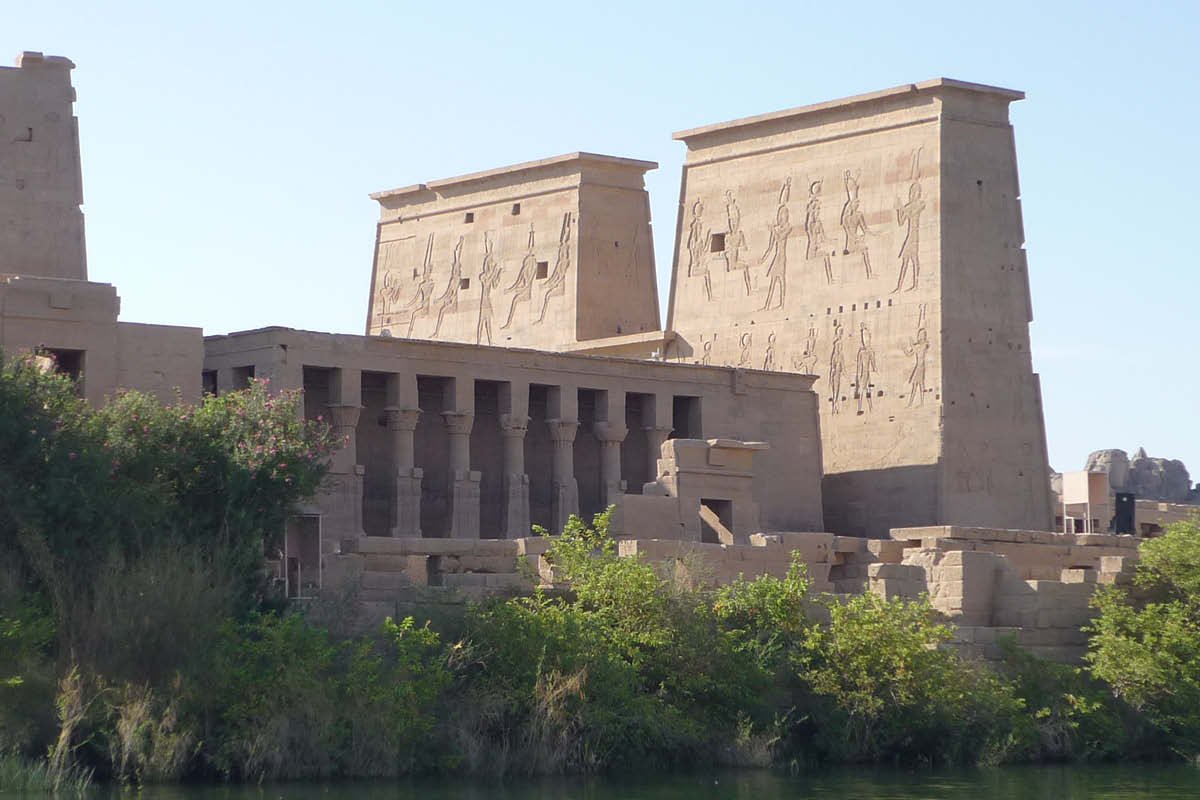Philae Temple: Isis Sanctuary on the Nile
Philae rising from the water.
An island of stone in bright water. Colonnades frame sky; reliefs pick up the sun; boats arrive as if the temple were moored to the river itself. Philae feels intimate compared with the vastness of Karnak, yet its plan is textbook: a pylon, a forecourt, hypostyle spaces, and a tight sanctuary for Isis. It is also a modern story—engineers cut the complex block by block and moved the island to save it from rising water. Keep the wider patterns of ancient Egyptian architecture in mind as we place Philae’s choices in that long tradition.
Definition
Naos: a stone shrine for the cult image, usually in the sanctuary’s core.
An island plan that stages approach
Philae’s axis runs clean from river edge to shrine. You pass the First Pylon into a sunlit court, then step into roofed halls that narrow toward the sanctuary. Columns keep rhythm; walls “speak” in reliefs and hieroglyphs. The sequence is the same logic we meet at Edfu—public brightness outside, concentrated presence inside—scaled to an island footprint. Porticoes along the water read like verandas for processions; the cult bark could arrive and depart by quay, turning the Nile into part of the temple’s route. Side chapels orbit the core for Osiris, Hathor, and other related cults, but everything defers to Isis-as-mother and healer, a role that stayed potent into late periods (watch for solar-fury and healing symbols when Eye of Ra vs Eye of Horus motifs appear in texts and crowns).
Reliefs and messages in a late, living cult
Most of the complex is Ptolemaic to Roman in date, so you’ll see kings in pharaonic dress offering to gods in a very traditional script—proof that the temple grammar outlasted dynasties. Reliefs repeat dependable scene types: the ruler presenting maat (order), Isis enthroned, Horus receiving offerings, priests carrying the bark shrine. Repetition isn’t decorative; it’s ritual reliability. Inscriptions layer hymns, inventories, and festival routes, so the building reads like a schedule as much as a picture book. Details vary by chamber, but the program keeps one promise: Isis protects and restores, the royal house guarantees order, and the city participates through processions across water. For a closely related manual of rooms and roles, compare the clarity at Edfu Temple—same grammar, different setting.
Sound-and-light glow at Philae.
A sanctuary saved: the modern relocation
Twentieth-century dams at Aswan raised water around Philae. The island flooded seasonally; foundations soaked; reliefs crusted with salts. The answer was radical and exacting. Before Lake Nasser stabilized at higher levels, conservation teams dismantled the temple complex, mapped every block, and re-erected it on nearby Agilkia Island, reshaped to echo the original site. The rescue preserved orientation and sequence: pylon to court to hypostyle to naos, with quays reset so boats still “read” as part of the liturgy. It also cemented Philae’s status as an emblem of how engineering and heritage can cooperate when water threatens stone. The result is a temple you can still walk in order, with masonry joints and platform lines quietly telling the story of its second birth.
Why Philae matters
Philae ties together three scales: a precise plan that teaches temple logic, a river setting that makes water part of ritual, and a modern rescue that kept both intact. It shows how a living cult adapted late, how architecture can choreograph belief in small spaces, and how heritage survives when design meets engineering with patience. If you know the general rules of Egyptian sacred building, this island feels like a distilled lesson in sequence—and an argument for why that sequence still moves us.
Twin pylons of the Temple of Isis at Philae.
Quick visitor notes (two minutes, tops)
Arrive by boat and let the quay be your “first room.” Pause in the forecourt to read the pylon scale against the sky. Inside, notice how columns thicken the air and sound; the sanctuary’s compact naos rewards a quiet minute. Then step back out to the river edge: the temple’s best “room” is sometimes the water that made it possible.












